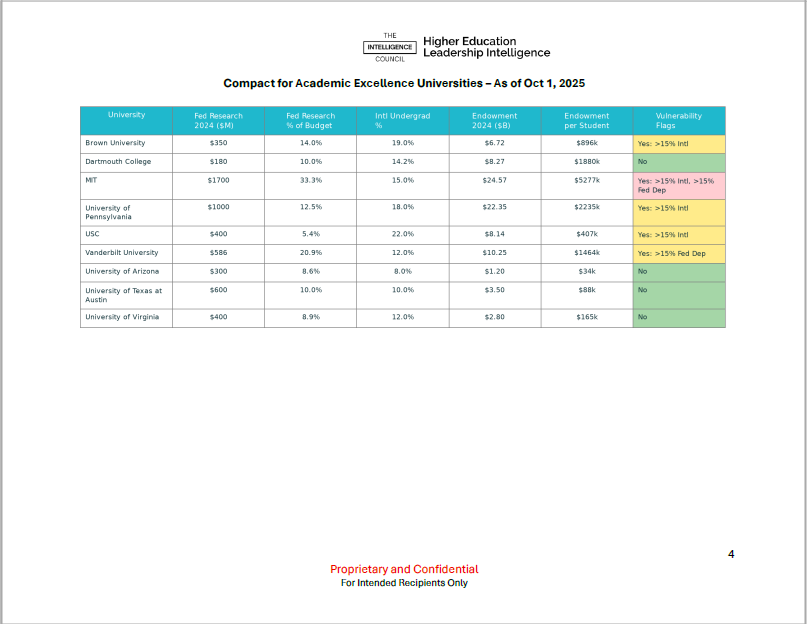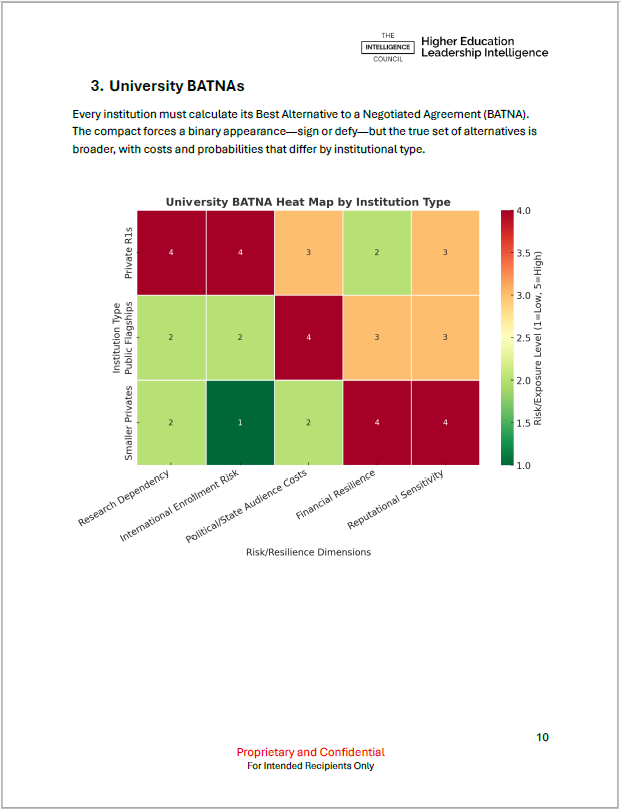Nine elite universities have been presented with a 10-point federal “Compact” that ties preferential access to research funds and indirect cost relief to a set of political and operational mandates: tuition freezes, caps on international enrollment, speech and gender provisions, and new reporting requirements. For institutions such as MIT, Vanderbilt, and Penn, where federal research dollars account for 20–33% of budgets, the stakes are existential. The White House has deliberately framed this as an ultimatum, forcing presidents and trustees to decide whether to sign, stall, or fight under public scrutiny.
The Intelligence Council has applied the tools of game theory and advanced negotiation science from the Harvard Negotiation Project, international bargaining case studies, and mechanism design in economics, to the Compact now confronting higher education. The aim is not abstract modeling but to make the structure of the problem legible: who holds power, what levers exist, and how choices cascade when multiple actors move under public scrutiny. While the Compact was delivered yesterday to nine elite universities, it is clearly a prototype that will extend further. This analysis is therefore written not only for their presidents, provosts, trustees, and advisors, but also for institutional leaders across higher education who will soon face similar terms.
The structure of the Compact creates what is known as a constrained gameboard. It resembles an Ultimatum Game in which the administration moved first with carrots and sticks, a Stag Hunt where collective resistance only succeeds if institutions trust each other not to defect, and a Repeated Game where today’s choices set enforcement precedents for years. Signing early secures short-term stability but signals capitulation; litigating is high-variance and resource-intensive; and delay creates space to negotiate but risks gradual funding slowdowns. Absent coordination, the most likely outcome is fragmentation, with a handful of early signers rewarded and others left exposed.
The Intelligence Council believes a stronger path lies in reframing the debate from ideology to outcomes. Universities can present multiple equivalent compliance packages—linking tuition growth to inflation, adopting Chicago-style free expression principles with external audits, publishing grade distributions and program-level outcomes, or capping international enrollments by program rather than across the board. These approaches meet the administration’s stated aims while protecting institutional autonomy. To succeed, they must be offered through disciplined coalitions rather than individual bargains.
Leverage must also be manufactured. Universities can raise the administration’s audience costs by appearing reasonable and verifiable, buy time through clarification rounds and pilot periods, preserve option value with reversible commitments, hedge funding with state and foundation partners, and prepare litigation in favorable circuits. By combining coalition discipline with credible alternatives, universities can transform a binary ultimatum into a reciprocal compact that protects core autonomy while credibly addressing national priorities.
Advisory Brief on the Compact for Academic Excellence
Yesterday’s White House Compact reached nine universities; more will follow. Our team has prepared an advisory brief that applies advanced negotiation frameworks and game theory models to map the choices ahead.
The full brief includes:
- The Game on the Table
Applies core game theory models—ultimatum, stag hunt, repeated games—to map the choices universities face and the audiences they must answer to. - What the Administration Optimized For
Dissects how the Compact was engineered through bundling, time asymmetry, and focal-point creation to tilt universities toward quiet acceptance. - University BATNAs
Assesses the real “best alternatives to a negotiated agreement” available to different institution types, from early signing to litigation to funding diversification. - Likely Response Paths (Payoff Matrix)
Forecasts outcomes under three strategic scenarios—early signing, coordinated delay, and fragmentation—showing trade-offs in research dollars, autonomy, and reputation. - A Negotiation Playbook That Changes the Game
Outlines practical moves—MESOs, unbundling, credibility stacks—that allow leaders to reframe the Compact into measurable, content-neutral commitments. - How to Manufacture Leverage You Don’t Have
Details tools for weaker players: audience costs, time arbitrage, funding hedges, and forum shopping to alter the bargaining balance. - Predicting Moves (Next 60–120 Days)
Provides a near-term forecast of how the White House and peer institutions are most likely to sequence actions—and how to prepare. - The “Way Out” Design (A Reciprocal Compact)
Proposes an alternative, verifiable compact that aligns with legitimate federal aims while preserving institutional autonomy. - Executive Path Forward (Action Checklist)
A board-ready checklist to brief trustees, form coalitions, set red lines, and prepare negotiation teams for the months ahead.
Sample Contents











